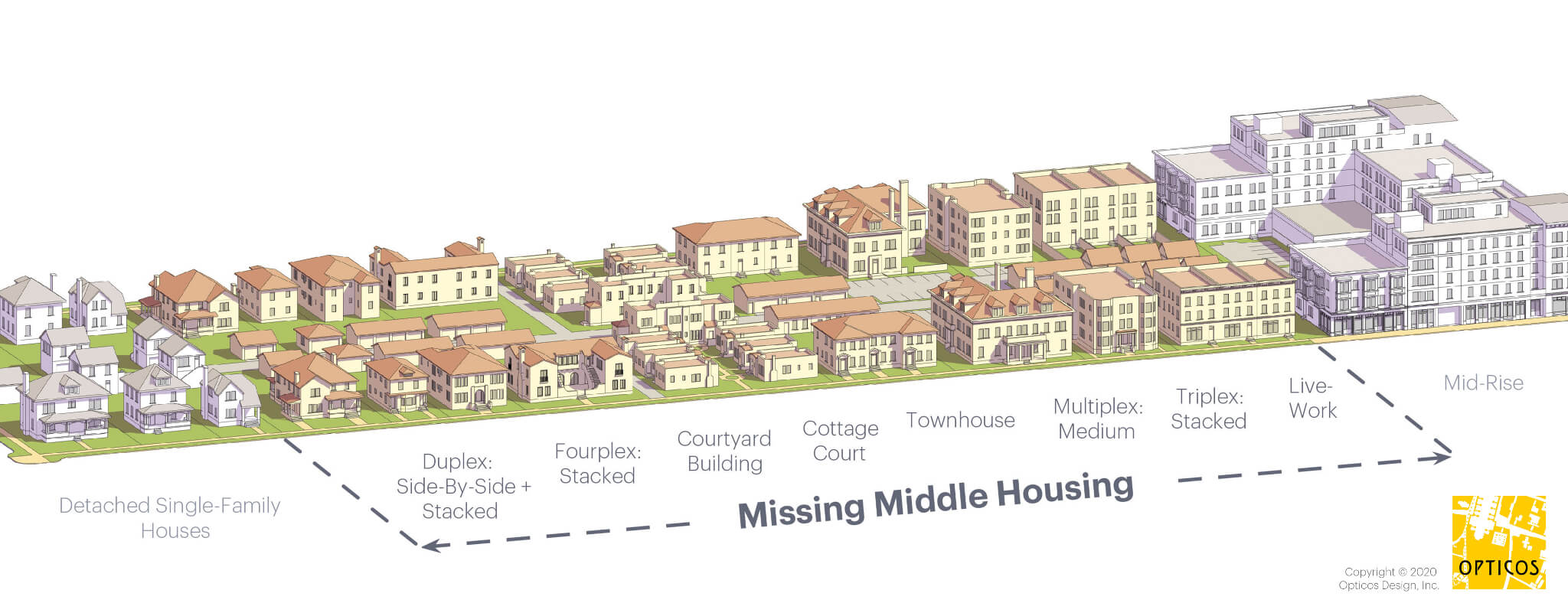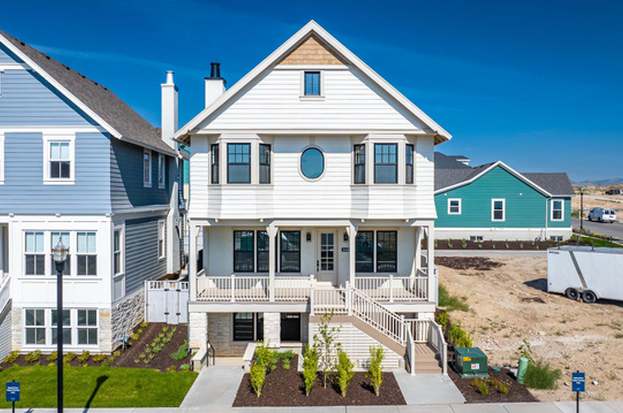Missing Middle Housing Toolkit
This is the homepage for Utah's Missing Middle Housing Toolkit! The Toolkit is currently being developed, with basic information found below in the meantime. Check back often for updates as the Toolkit comes online for open and free use.

Missing middle housing types contribute to the diversity of housing options in form, affordability, and availability. They can be both an owner-occupied and rental option that works extremely well for first-time home buyers, single adults, smaller families, couples, empty-nesters, retirees, car-free households, and many more. Missing middle units can include several households within a building, shared space, or compact area, offering an alternative to the standard traditional single-family or higher-density condominium or apartment options.
*The term “Missing Middle Housing” was coined by architect Daniel Parolek, see https://opticosdesign.com/missing-middle-housing/
While Utah has a selection of projects all throughout the state that could be considered missing middle housing in both newer and more established neighborhoods, the most commonly seen type of missing middle development has shifted over the years. As detailed within the Utah Foundation’s Middle Housing Study, the placement of missing middle housing types, such as smaller multiplexes (duplexes, triplexes, and fourplexes), was more common in the 1950s through the 1980s.
Since the early 2000s, townhome products have become the more common missing middle development type, with very few smaller multiplex developments being placed. During this same time period, construction of traditional separated single-family homes and larger-scale multi-family apartments have continued to be the predominant housing deliverable, with over 85% of units built falling within those two categories. However, many communities throughout the state are now more focused on placing developments that include a mix of housing types from individual single-family units, missing middle, and higher-density multi-family units sharing space within communities in a cohesive and strategic manner that centers on community character and quality of life.
More established neighborhoods, particularly in areas where higher educational institutions are located, have incorporated missing middle housing concepts for many years. Many neighborhoods in Provo, Salt Lake City, Ogden, Logan, Cedar City, and St. George have a mix of single-family and missing middle units that co-exist together.









Affordable housing options have become harder to find as prices have risen throughout Utah. Developing and maintaining missing middle housing increases the housing stock within communities while supporting various demographics looking for more affordable housing options. Missing middle housing products are designed to be walkable, sustainable, and more accessible, attracting a diverse group of people across all demographics. A diverse set of housing options makes it more possible for our parents, siblings, children, friends, and loved ones to remain in our communities throughout each phase of their lives.
In addition, missing middle homes are excellent for placement within existing neighborhoods where jobs, public services, infrastructure, transportation, entertainment, and retail options already exist; reducing the impacts of new growth by promoting efficient land use and avoiding undue taxpayer subsidy of new growth on the fringes of current communities.
In 2021-2022, the Utah Foundation, in partnership with Salt Lake County, the Sorenson Legacy Foundation, the Utah League of Cities and Towns, and the Wasatch Front Regional Council, completed the Middle Housing Study. The study examined:
- Utah’s overall housing challenges and introduced how missing middle products may assist in addressing the issues; and
- Relevant development trends and the prevalence of middle housing in the four largest counties in Utah; and
- Utahn’s development preferences and current practices; and
- Obstacles and opportunities for increasing the supply of middle housing in Utah.
In 2022-2023, The Governor’s Office of Planning and Budget, in partnership with the state’s seven associations of government, the Utah League of Cities and Towns, Envision Utah, the Kem C. Gardner Policy Institute, the Utah Land Use Institute, the Department of Workforce Services, and several other stakeholders, conducted a statewide conversation about how we can keep Utah a great place for our families and communities as we grow, titled Guiding Our Growth. A major component of these conversations was a comprehensive survey of Utahns regarding their preferred development patterns and styles, including development types within the missing middle range. Significant effort was made to ensure outreach to all areas of the state, including all 29 counties of Utah. In total, 21 community presentations were made, 15 in-person workshops were conducted, over 1.7 million online interactions were completed, 68,000 ad campaign clicks, and 19,000+ complete survey responses were tallied.
Analysis from both of the aforementioned efforts confirmed Utahns' continued concerns about four key areas, including:
- Access to housing that is affordable
- Desire to have a variety of housing product types available within their communities
- Convenient access to jobs, goods, and services
- Protecting and enhancing the character of their existing communities
The placement of missing middle housing types addresses all four key areas identified as most critical to Utahns. First, missing middle housing units provide for greater affordability as a result of lower overall development costs due to the utilization of existing infrastructure, more efficient use of land, and the ability to serve a larger number of residents in buildings that are at a single-family residential scale. Second, because of the range of options missing middle housing covers, the various housing needs and preferences of Utah residents across all spectrums can be better served. Third, because missing middle housing units are best placed in established communities, access to employment options, existing retail, and services already actively offered within the community are more readily available. Fourth, missing middle housing projects are designed to fit into existing neighborhoods; ensuring the area's aesthetic, setting, and nature are incorporated and enhanced.